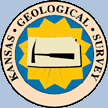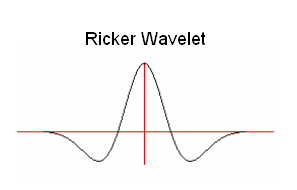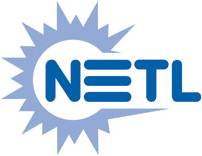
Synthetic Seismic Profile Plot Description


|
Synthetic Seismic Profile Plot Description |
 |
| Main Page | Description | Applet | Download | Help | Copyright & Disclaimer | |
Work is partially supported by the U.S. Department of Energy (DOE) National Energy Technology Laboratory (NETL) under Grant Number DE-FE0002056.
Dr. Paul Glover Petrophysics MSc Course Notes 1 provides a step-by-step reference for creating the synthetic seismogram and is paraphrased below. This program uses a data structure that automatically ties all the log curves to the depth as well as the computed travel time.
The synthetic seismogram is a seismic trace that has been contructed from well log data. It represents the idealize trace that should be observed with the seismic method at the location of the well. The Synthetic Seismic can be compared with the seismic trace actually measured at the well to improve the picking of seismic horizons, and to improve the accuracy and resolution of formations of interest.
The observed seismic trace is primarily a record of the ability of interfaces between formations to reflect elastic waves, which is called the reflection coefficent R. The reflection coefficient depends on the properties of the rock at the interface of the beds and in particular on its acoustic impedance. The acoustic impedance is the product of the seismic velocity and the density of the rock.
The following procedure was performed to create the Synthetic Seismogram in the Applet,
Surface to 1368.5 ft = 172.943 msec
| Depth | Acoustic transit time | Acoustic transit time * Step Depth | |
| DEPT | DT | 2 * DT * 0.5' | Time |
| (ft) | (μsec/ft) | (μsec) | (msec) |
| 1368.5 | 63.164 | 63.164 | 172.943 |
| 1369.0 | 63.164 | 63.164 | 173.006 |
| 1369.5 | 63.164 | 63.164 | 173.069 |
| 1370.0 | 63.164 | 63.164 | 173.132 |
| 1370.5 | 63.164 | 63.164 | 173.196 |
| 1371.0 | 63.809 | 63.809 | 173.259 |
| 1371.5 | 63.398 | 63.398 | 173.323 |
| 1372.0 | 64.102 | 64.102 | 173.387 |
| 1372.5 | 70.352 | 70.352 | 173.457 |
| 1373.0 | 63.809 | 63.809 | 173.521 |
| 1373.5 | 63.77 | 63.77 | 173.585 |
| 1374.0 | 63.574 | 63.574 | 173.649 |
| 1374.5 | 111.699 | 111.699 | 173.76 |
| 1375.0 | 111.426 | 111.426 | 173.872 |
| 1375.5 | 115.488 | 115.488 | 173.987 |
| 1376.0 | 123.691 | 123.691 | 174.111 |
| 1376.5 | 116.719 | 116.719 | 174.228 |
| 1377.0 | 108.984 | 108.984 | 174.337 |
| 1377.5 | 155.234 | 155.234 | 174.492 |
| 1378.0 | 154.072 | 154.072 | 174.646 |
| 1378.5 | 148.145 | 148.145 | 174.794 |
| 1379.0 | 144.883 | 144.883 | 174.939 |
| 1379.5 | 109.941 | 109.941 | 175.049 |
| 1380.0 | 114.414 | 114.414 | 175.163 |
| 1380.5 | 112.598 | 112.598 | 175.276 |
| Depth | Acoustic transit time | Wave Velocity | |
| DEPT | Time | DT | V=106/DT |
| (ft) | (msec) | (μsec/ft) | (ft/sec) |
| 1368.5 | 172.943 | 63.164 | 15831.803 |
| 1369.0 | 173.006 | 63.164 | 15831.803 |
| 1369.5 | 173.069 | 63.164 | 15831.803 |
| 1370.0 | 173.132 | 63.164 | 15831.803 |
| 1370.5 | 173.196 | 63.164 | 15831.803 |
| 1371.0 | 173.259 | 63.809 | 15671.77 |
| 1371.5 | 173.323 | 63.398 | 15773.368 |
| 1372.0 | 173.387 | 64.102 | 15600.137 |
| 1372.5 | 173.457 | 70.352 | 14214.237 |
| 1373.0 | 173.521 | 63.809 | 15671.77 |
| 1373.5 | 173.585 | 63.77 | 15681.355 |
| 1374.0 | 173.649 | 63.574 | 15729.701 |
| 1374.5 | 173.76 | 111.699 | 8952.632 |
| 1375.0 | 173.872 | 111.426 | 8974.566 |
| 1375.5 | 173.987 | 115.488 | 8658.908 |
| 1376.0 | 174.111 | 123.691 | 8084.663 |
| 1376.5 | 174.228 | 116.719 | 8567.585 |
| 1377.0 | 174.337 | 108.984 | 9175.659 |
| 1377.5 | 174.492 | 155.234 | 6441.888 |
| 1378.0 | 174.646 | 154.072 | 6490.472 |
| 1378.5 | 174.794 | 148.145 | 6750.143 |
| 1379.0 | 174.939 | 144.883 | 6902.121 |
| 1379.5 | 175.049 | 109.941 | 9095.788 |
| 1380.0 | 175.163 | 114.414 | 8740.189 |
| 1380.5 | 175.276 | 112.598 | 8881.152 |
| Depth | Acoustic transit time | Wave Velocity | Bulk Density | Acoustic Impedance | |
| DEPT | Time | DT | V=106/DT | RHOB | AI=RHOB*V |
| (ft) | (msec) | (μsec/ft) | (ft/sec) | (gm/cc) | (gm/cc-ft/sec) |
| 1368.5 | 172.943 | 63.164 | 15831.803 | 2.997 | 47447.913 |
| 1369.0 | 173.006 | 63.164 | 15831.803 | 3.003 | 47542.904 |
| 1369.5 | 173.069 | 63.164 | 15831.803 | 3.021 | 47827.877 |
| 1370.0 | 173.132 | 63.164 | 15831.803 | 3.05 | 48286.999 |
| 1370.5 | 173.196 | 63.164 | 15831.803 | 3.079 | 48746.121 |
| 1371.0 | 173.259 | 63.809 | 15671.77 | 3.092 | 48457.114 |
| 1371.5 | 173.323 | 63.398 | 15773.368 | 3.083 | 48629.294 |
| 1372.0 | 173.387 | 64.102 | 15600.137 | 3.063 | 47783.22 |
| 1372.5 | 173.457 | 70.352 | 14214.237 | 3.042 | 43239.709 |
| 1373.0 | 173.521 | 63.809 | 15671.77 | 3.029 | 47469.793 |
| 1373.5 | 173.585 | 63.77 | 15681.355 | 3.033 | 47561.549 |
| 1374.0 | 173.649 | 63.574 | 15729.701 | 3.052 | 48007.047 |
| 1374.5 | 173.76 | 111.699 | 8952.632 | 3.071 | 27493.532 |
| 1375.0 | 173.872 | 111.426 | 8974.566 | 3.067 | 27524.994 |
| 1375.5 | 173.987 | 115.488 | 8658.908 | 3.04 | 26323.081 |
| 1376.0 | 174.111 | 123.691 | 8084.663 | 3.001 | 24262.072 |
| 1376.5 | 174.228 | 116.719 | 8567.585 | 2.976 | 25497.134 |
| 1377.0 | 174.337 | 108.984 | 9175.659 | 2.971 | 27260.882 |
| 1377.5 | 174.492 | 155.234 | 6441.888 | 2.987 | 19241.919 |
| 1378.0 | 174.646 | 154.072 | 6490.472 | 3.013 | 19555.792 |
| 1378.5 | 174.794 | 148.145 | 6750.143 | 3.025 | 20419.184 |
| 1379.0 | 174.939 | 144.883 | 6902.121 | 3.019 | 20837.503 |
| 1379.5 | 175.049 | 109.941 | 9095.788 | 2.997 | 27260.076 |
| 1380.0 | 175.163 | 114.414 | 8740.189 | 2.99 | 26133.166 |
| 1380.5 | 175.276 | 112.598 | 8881.152 | 3.017 | 26794.437 |
| ρ2 * V2 - ρ1 * V1 | |
| R= | ---------------------- |
| ρ2 * V2 + ρ1 * V1 |
where the subscript 2 refers to the formation below an interface, and the subscript 1 to the formation above it.
| Depth | Acoustic transit time | Wave Velocity | Bulk Density | Acoustic Impedance | Reflection Coefficient | |
| DEPT | Time | DT | V=106/DT | RHOB | AI=RHOB*V | |
| (ft) | (msec) | (μsec/ft) | (ft/sec) | (gm/cc) | (gm/cc-ft/sec) | |
| 1368.5 | 172.943 | 63.164 | 15831.803 | 2.997 | 47447.913 | 1.0 |
| 1369.0 | 173.006 | 63.164 | 15831.803 | 3.003 | 47542.904 | 0.001 |
| 1369.5 | 173.069 | 63.164 | 15831.803 | 3.021 | 47827.877 | 0.003 |
| 1370.0 | 173.132 | 63.164 | 15831.803 | 3.05 | 48286.999 | 0.005 |
| 1370.5 | 173.196 | 63.164 | 15831.803 | 3.079 | 48746.121 | 0.005 |
| 1371.0 | 173.259 | 63.809 | 15671.77 | 3.092 | 48457.114 | -0.003 |
| 1371.5 | 173.323 | 63.398 | 15773.368 | 3.083 | 48629.294 | 0.002 |
| 1372.0 | 173.387 | 64.102 | 15600.137 | 3.063 | 47783.22 | -0.009 |
| 1372.5 | 173.457 | 70.352 | 14214.237 | 3.042 | 43239.709 | -0.05 |
| 1373.0 | 173.521 | 63.809 | 15671.77 | 3.029 | 47469.793 | 0.047 |
| 1373.5 | 173.585 | 63.77 | 15681.355 | 3.033 | 47561.549 | 0.001 |
| 1374.0 | 173.649 | 63.574 | 15729.701 | 3.052 | 48007.047 | 0.005 |
| 1374.5 | 173.76 | 111.699 | 8952.632 | 3.071 | 27493.532 | -0.272 |
| 1375.0 | 173.872 | 111.426 | 8974.566 | 3.067 | 27524.994 | 0.001 |
| 1375.5 | 173.987 | 115.488 | 8658.908 | 3.04 | 26323.081 | -0.022 |
| 1376.0 | 174.111 | 123.691 | 8084.663 | 3.001 | 24262.072 | -0.041 |
| 1376.5 | 174.228 | 116.719 | 8567.585 | 2.976 | 25497.134 | 0.025 |
| 1377.0 | 174.337 | 108.984 | 9175.659 | 2.971 | 27260.882 | 0.033 |
| 1377.5 | 174.492 | 155.234 | 6441.888 | 2.987 | 19241.919 | -0.172 |
| 1378.0 | 174.646 | 154.072 | 6490.472 | 3.013 | 19555.792 | 0.008 |
| 1378.5 | 174.794 | 148.145 | 6750.143 | 3.025 | 20419.184 | 0.0216 |
| 1379.0 | 174.939 | 144.883 | 6902.121 | 3.019 | 20837.503 | 0.01 |
| 1379.5 | 175.049 | 109.941 | 9095.788 | 2.997 | 27260.076 | 0.134 |
| 1380.0 | 175.163 | 114.414 | 8740.189 | 2.99 | 26133.166 | -0.021 |
| 1380.5 | 175.276 | 112.598 | 8881.152 | 3.017 | 26794.437 | 0.012 |

Figure 1: Ricker Wavelet2

This web application will take advantage of over 11 years of Java development experience at the Kansas Geological Survey (KGS) in developing web applications that plot oil & gas data and allows the geologist to perform analysis with that data, i.e. GEMINI Project & Tools on the KGS Web Site.
GEMINI (Geo-Engineering Modeling through INternet Informatics) Project was developed to allow the geologist to seamlessly integrate databases and geological analytical tools across the web. Analytical tools were designed for the independent oil and gas operators, consultants, and widely separated team members within and outside companies.
The web application can read up to 3 Log ASCII Standard (LAS) version 2.0 & 3.0 files using the standard developed by the Canadian Well Logging Society5 .
Reference:
(1) Petrophysics MSc Course Notes - 16. THE SONIC OR ACOUSTIC LOG pgs 187, 188, by Dr. Paul Glover
http://www2.ggl.ulaval.ca/personnel/paglover/CD%20Contents/GGL-66565%20Petrophysics%20English/Chapter%2016.PDF
(2) Ricker, Ormsby, Klauder, Butterworth - A Choice of wavelets by Harold Ryan, September, 1994 CSEG Recorder
http://www.cseg.ca/publications/recorder/1994/09sep/sep94-choice-of-wavelets.pdf
(3) Synthetic sonic logs-a process for stratigraphic interpretation by R.0. Lindseth,
GEOPHYSICS, VOL. 44, NO. 1 (JANUARY 1979); P. 3-26,
http://eps.mcgill.ca/~courses/c551/SEISMIC-DATA-PROCESSING-II/Chapter3-3D/Impedance/Lindseth1979-geo4401r00030026.pdf
(4) Tutorial: Good practice in well ties by Roy White and Rob Simm, First break volume 21, October 2003,
FB october v5 18-09-2003 17:20 Pagina 75
http://www.rock-physics.com/papers_downloads/RPA_white_and_simm_2003.pdf
(5) LAS 3.0 Log ASCII Standard Document #1 File Structures by
Canadian Well Logging Society:
http://www.cwls.org/las_info.php
Author: John R. Victorine
jvictor@kgs.ku.edu
The URL for this page is http://www.kgs.ku.edu/software/SS/description.html

